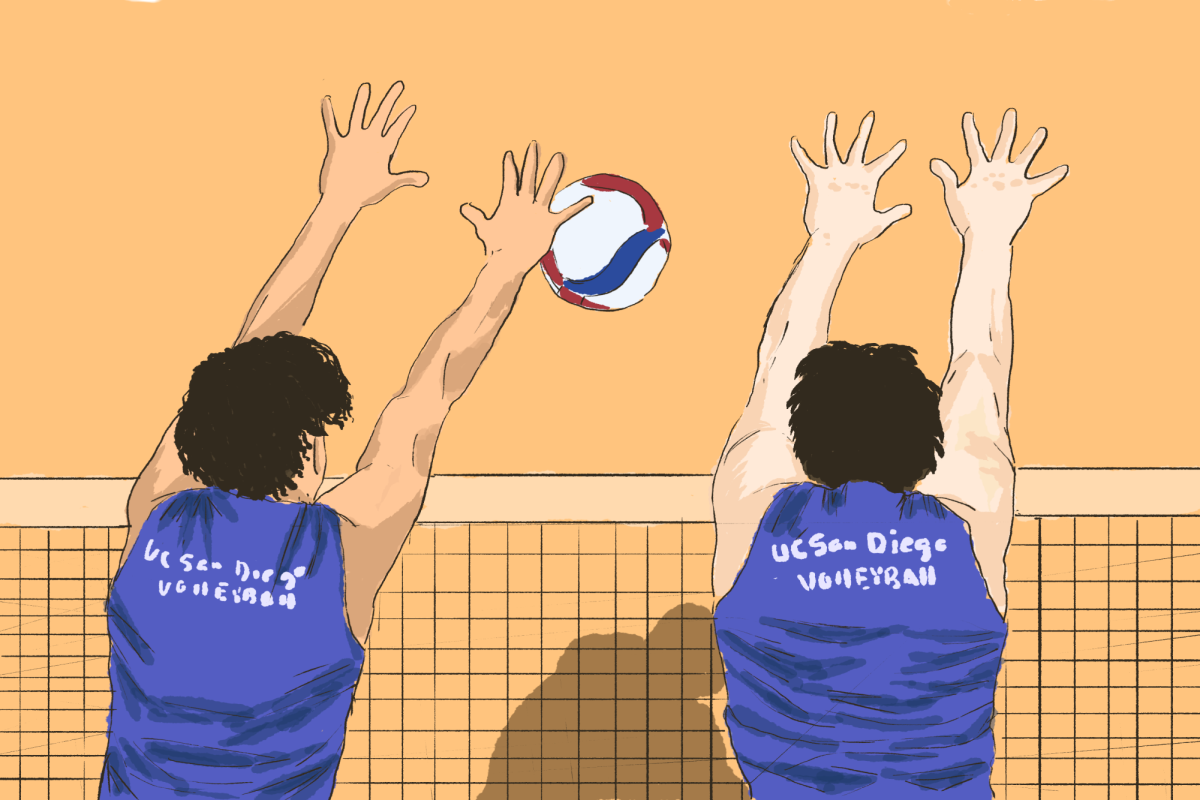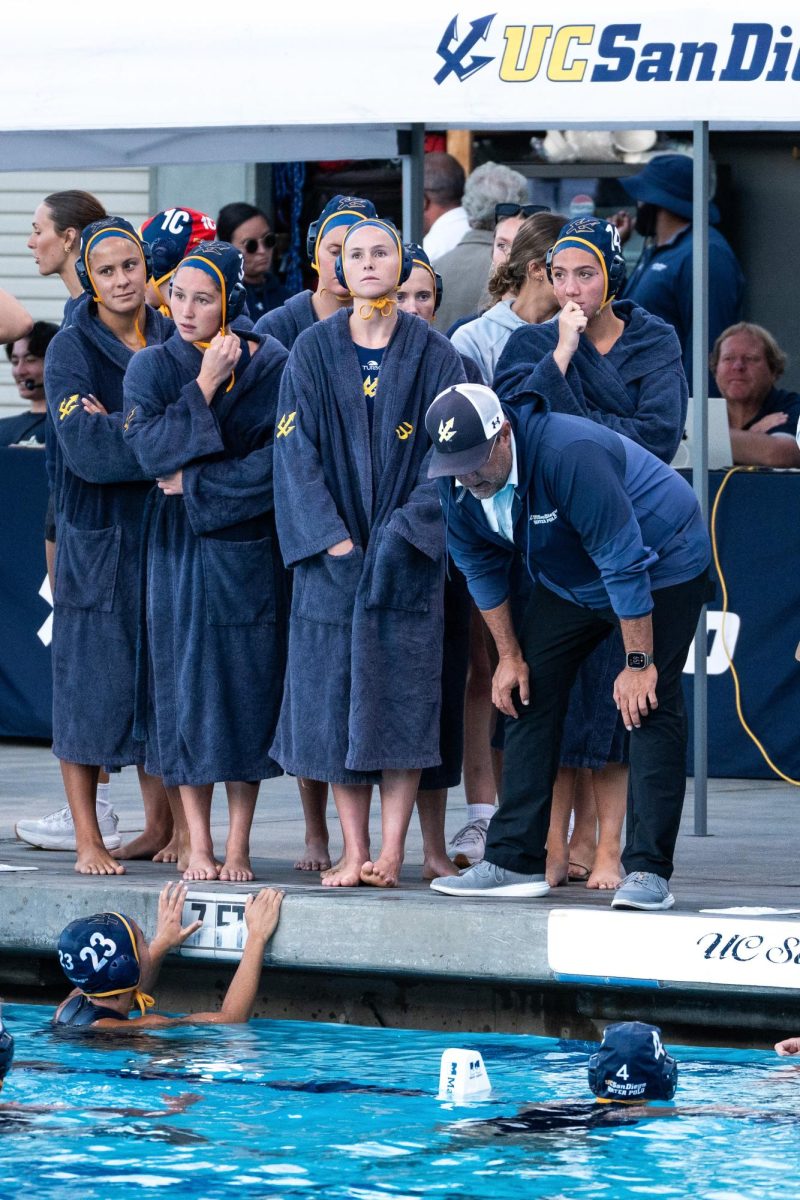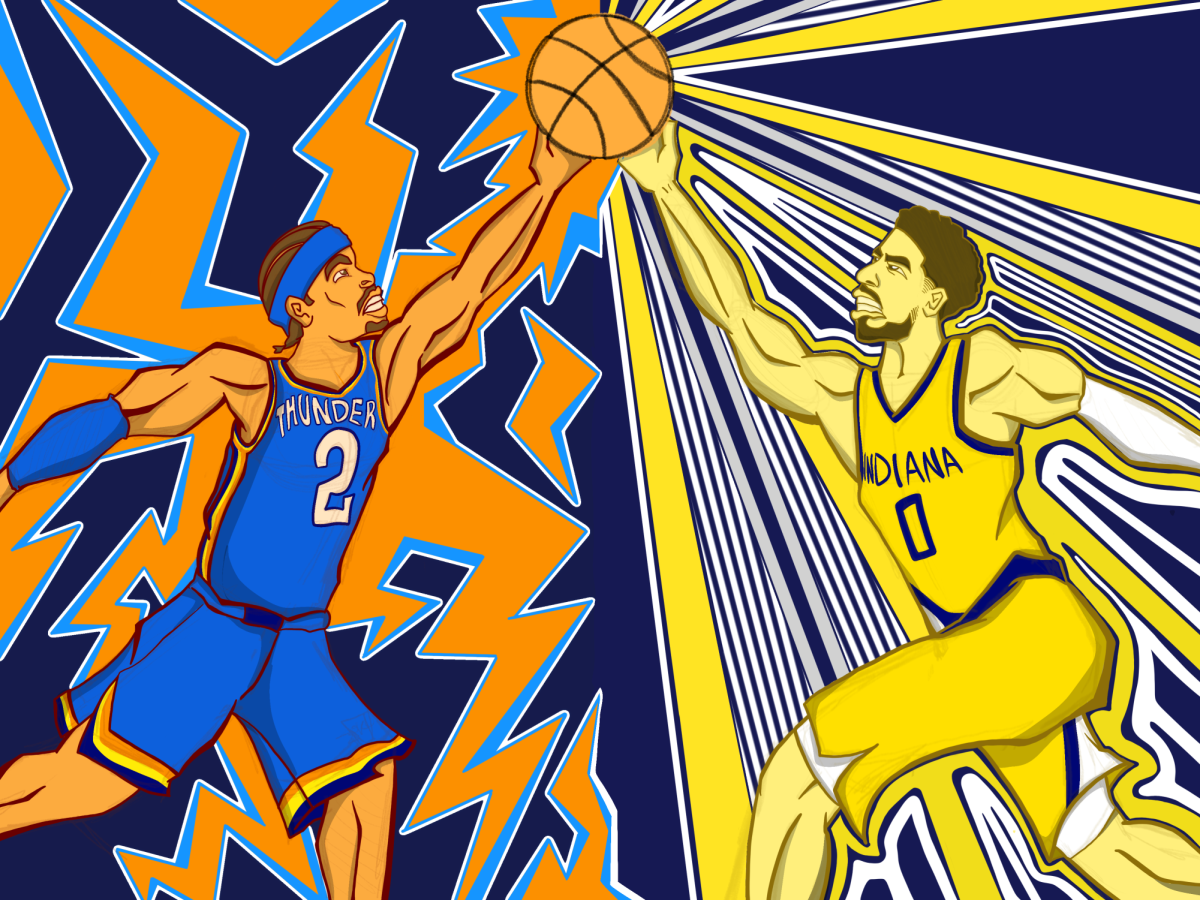Marshall Olmos was crushed. It was Jan. 11; UC Irvine men’s basketball was playing at UC San Diego in one of the most anticipated matchups in Big West history. In a defensive battle that ended 60-52, the Tritons lost, a result that Olmos had not experienced from his play-by-play chair in over two months.
But in the wake of this defeat, Olmos, a fourth-year radio commentator and the first director of KSDT Sports, began hatching a plan. It would later be named Operation Invade Irvine, where Olmos, alongside the rest of the KSDT Sports team, gathered hundreds of students to make the trip to the Bren Events Center to cheer on men’s basketball in their game against the Anteaters on Feb. 8. For over three hours, nearly 300 Tritons stood on their feet, loudly cheering on the team as they won 85-67. Olmos sat down with The UCSD Guardian afterward to discuss the campaign and its significance in the broader context of Triton basketball fandom.
“The first game I called was our home opener loss to Seattle University,” Olmos said. “Nobody cared at the time that we lost. After the loss against Irvine, some of the KSDT Sports marketers came down to visit us at the broadcasting table, and I saw a look of deep sadness on their faces. … I had a bit of a reverse reaction at that moment; I realized that it created an opportunity.”
That opportunity — the realization that people could genuinely care about UCSD athletics — became the foundation of Operation Invade Irvine. Only two days after the loss, sitting in that KSDT Sports marketing meeting, he pitched his vision for the first time and asked who wanted to be a part of it.
“Basically everyone’s hands went up,” he said. “That’s when I knew it could happen, because I was able to sell it to a room of 20 people. That means each and every one of those people could sell it to a significant number of people, and it would propagate.”
At the beginning of the season, even the idea that they could launch a large-scale campaign to bring people to an away game like this was unthinkable. Founded only two years ago, KSDT Sports grew from a small team to a full-fledged broadcasting program with a large production and marketing team filled with dozens of broadcasters, marketers, and interns. With a strong infrastructure and staff around him, Olmos fully believed in the plan.
“I believed in it, that it was possible to sell all of them,” Olmos said. “I believed in myself. I believed in KSDT Sports and all the marketers who made it happen, and the belief manifested into reality.”
For Olmos, the goal of Operation Invade Irvine wasn’t just to get Triton fans to care about their team — it was also to get Anteater fans to care about their team too.
“I wanted to provoke them,” he said. “I wanted them to see how it was done. I wanted to show that this is what caring about sports is like.”
He went on to explain that one of the main issues lies in the UCI student section, the “Antourage.”
“Not to hate, their [social media] content is some of the most low-effort content I’ve ever seen,” Olmos said. “There is no talk about the team. There is talk about ‘Show up! Oh my god, they’re invading us!’ There’s no talk about how great their team is.”
Many Anteater fans seemed to know little about their team. Before the game, a Triton fan mentioned that they were carrying an Aniwaniwa Tait-Jones sign and received a cheer from a group of Anteater fans, who were seemingly unaware that Tait-Jones played for their rivals.
Not only do they lack knowledge about their own team, they seem to know even less about their opponents. During the game, a UCI student sitting behind the broadcast table yelled, “Tyler McGhie, you suck!” at regular intervals, even while McGhie sat on the bench through foul trouble. The fan seemingly had no idea that his talents could be better used yelling at one of the players actually on the court. It is entirely possible he had no clue who McGhie was or what he looked like.
“[UCI head coach] Russell Turner deserves for students to be invested,” Olmos said. “He’s done all the work possible, and they’re still not invested like they should be. Bent Leuchten, Myles Che, Justin Hohn, Devin Tillis; all these players have done so much for that school and might get them to their first [national] tournament since 2019. They deserve to have people genuinely care and not just show up because it’s a big game.”
Unlike the Anteaters — who have struggled to gain a consistent student fan base for decades — the Tritons are still new to Division I, having only joined five years ago before the 2020-21 season. This gives UCSD the opportunity to build its fan culture from the ground up, a prospect that excited Olmos, a longtime basketball fan who longed for a community that cared about and took pride in its college athletics.
Luckily for Olmos and KSDT Sports, the story of the 2024-25 Tritons is not a hard one to sell. The Tritons currently sit at 26-4 and are ranked within the top 35 by both KenPom and NET, making them the highest-ranked team ever in their first year out of transition. The Tritons’ success had fallen into KSDT Sports’ laps; all they needed to do was get people to care.
“Anyone is capable of creating and crafting a story, as long as they care about it,” Olmos said. “Us being at the beginning of our story in Division I, and realizing that frankly no one else cared, meant that we had a golden opportunity.”
Using storytelling to bring in fans contrasts with the way that many college sports marketing departments operate. Marketing is a numbers game; what matters most is bringing people in. Many mid-majors use giveaways as a primary tactic to bring in students since they lack the fan bases of power schools. The idea behind these giveaways is that if you get people to show up with the promise of goodies, they might also enjoy the experience and come back. And to a degree, it works; for a night, people show up, but they don’t come back until you offer them more free stuff.
When the Tritons played UCI at home, it was clear that the goal from UCSD’s marketing team was to fill up the arena by any means possible. People came and received free jerseys, with a navy blue “1” plastered on the front and back. UCSD actually has a player that wears the number, freshman guard Ryder Elisaldez, a fact that was not acknowledged during the giveaway. It is possible that the staff did not notice he wore that number when ordering the jerseys. The importance of the game could not have been understated; the Tritons were on national television at home for the first time, the game was the highest-ranked Big West matchup in decades, and the Tritons held the longest active winning streak in the nation. Without this wider context and knowing what’s at stake, the game is meaningless. At that point, it’s just a regular basketball game between two teams where fans unknowingly received a free Ryder Elisaldez jersey.
Two Saturdays later, on Jan. 25, UCSD men’s basketball played at home again. Their opponent was Cal State Northridge, another excellent team that would go on to record their first 20+ win season since 2008. The arena that night was less than half full, despite full student sections at the previous two home games. The fans did not show up again because the giveaways did not get them invested in the team; they were only invested in the idea of free stuff, which is not a sustainable strategy given that items as costly as a jersey cannot be handed out every night. Selling out the student section at home against the Anteaters wasn’t a success — it was bribery.
By neglecting storytelling, UCSD runs the risk of making the same mistake as many schools before them, including UCI. Despite having one of the strongest mid-major programs in the nation, most Anteater fans have no passion. Even in their own arena, they were consistently drowned out by the Triton fans in attendance. Despite being outnumbered nearly 3-to-1, the Tritons controlled the atmosphere for much of the night. Many UCI fans’ signs were vague; most required little knowledge of the team, focusing on the schools and mascots rather than the players and teams on the court.
“What’s a Triton?” Olmos laughed, remembering one of their signs. “If you don’t know who Bent Leuchten is, that’s a problem. If you don’t know who Russell Turner is, that’s a problem.”
Operation Invade Irvine was the antithesis of these marketing gimmicks. The numbers weren’t astronomical; only about a fifth of the students who attended the previous game against the Anteaters made the drive up. But to that group of fans, this game mattered to them because they genuinely cared about this team — the result of a marketing campaign that emphasized the game’s story and importance, as well as the wider success of the team.
“We did not create this story,” Olmos said. “The players and coaches created this story, for us to be this good in our first year of eligibility. It is our responsibility to tell that story and give it the correct amount of attention to detail that it deserves.”
After the game, in which UCSD shot more than 50% from beyond the arc, the Tritons showed their appreciation for the traveling faithful. Olmos watched on as his beloved team embraced their fans, taking pictures with their supporters as the Anteater fans filed out grimly. Olmos teared up, and on his broadcast he declared the night “the greatest night in UCSD history.” He had done it: The invasion had succeeded.
Everyone from that night will one day leave La Jolla. In five years, our men’s basketball team will look entirely different. The players will be gone and so will most of the students. It’s entirely possible that this chapter of UCSD basketball will fade into obscurity. But for one night in February, the Triton faithful were there to celebrate this story — the story of a team accomplishing something that no program this new to Division I ever had, the story of a head coach who had dedicated his entire adult life to a school, and the story of a group of college radio broadcasters who inspired nearly 300 fans to care about their team as much as they did.










